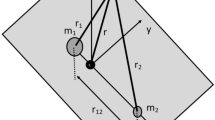Abstract
Thispaper investigates the micro-satellite cluster long-distance gathering control problem including initialization, orbit maintenance and collision avoidance operations. This problem is formulated using absolute orbital elements and newly developed quadratic artificial potential function based on these elements. Incorporating with the artificial potential function, a distributed autonomous low-thrust control method is proposed to solve the cluster gathering problem. Comparing with the fuel-optimal control problem formulated by equations established in Cartesian coordinates, the proposed method demonstrates geometrical intuition and possesses a low-cost computation burden. These advantages make the proposed method more suitable for controlling micro-satellite clusters. The stability of the autonomous low-thrust control method is proved using the Lyapunov method. Additionally, a Monte Carlo analysis is applied to demonstrate both the effectiveness and the collision avoidance ability of the presented algorithm.












Similar content being viewed by others
Change history
20 April 2021
A Correction to this paper has been published: https://doi.org/10.1007/s40295-021-00262-3
References
Scharf, D.P., Hadaegh, F.Y., Ploen, S.R.: A survey of spacecraft formation flying guidance and control (Part I): guidance, Denver, CO. In: Proceedings of the 2003 American Control Conference, pp 1733–1739 (2003)
Renevey, S., David, A.: Spencer: establishment and control of spacecraft formations using artificial potential functions. Acta Astronautica 162, 314–326 (2019)
Scharf, D.P., Hadaegh, F.Y., Ploen, S.R.: A survey of spacecraft formation flying guidance and control (Part II): control. In: Proceedings of the 2004 American Control Conference, Boston, MA, pp 2976–2985 (2004)
Zhou, D., et al.: Distributionally robust planning for data delivery in distributed satellite cluster network. IEEE Trans. Wireless Commun. 18(7), 3642–3657 (2019)
Wang, Z., Xu, Y., Jiang, C., Zhang, Y.: Self-organizing control for satellite clusters using artificial potential function in terms of relative orbital elements. Aerospace Sci. Technol. 84, 799–811 (2019)
Hesse, M., et al.: Theory and modeling for the magnetospheric multiscale mission. Space Sci. Rev. 199(1-4), 577–630 (2016)
Morris, M., Chew, C., Reager, J.T., Shah, R., Zuffada, C.: A novel approach to monitoring wetland dynamics using CYGNSS: everglades case study. Remote Sensing of Environment 233 (2019)
Harris, M.: Tech giants race to build orbital internet. IEEE Spectrum 55(6), 10–11 (2018)
del Portilloa, I., et al.: A technical comparison of three low earth orbit satellite constellation systems to provide global broadband. Acta Astronautica 159, 123–135 (2019)
Clohessy, W.H., Wiltshire, R.S.: Terminal guidance system for satellite rendezvous. Aerosp. Sci. 27(9), 653–658 (1960)
Lovell, T.A., Tragesser, S.G.: Guidance for relative motion of low earth orbit spacecraft based on relative orbit elements. In: AIAA/AAS Astrodynamics Specialist Conference and Exhibit, Providence, RI, pp 1–15 (2004)
Lin, L., Jingshi, T.: Satellite Orbit Theory and Application[M], pp 78–79. Publishing House of Electronics Industry Beijing, Beijing (2015)
Fakoor, M., Sadeghi, S., Bakhtiari, M.: Investigation of low thrust optimal orbital transfer from LEO to GEO considering circular orbits. The Journal of the Astronautical Sciences 67(1), 77–97 (2020)
Leomanni, M., Garulli, A., Giannitrapani, A., et al.: An adaptive groundtrack maintenance scheme for spacecraft with electric propulsion. Acta Astronautica 167, 460–466 (2020)
Shengqing, Y., Yu, W., Danna, W., Rong-Feng, L., Yao-ke, D., Chao, Z.: Study on maneuver methods of satellites constellation with continual small-thrust propulsion. Chinese Space Science and Technology 40(04), 69–77 (2020)
Khatib, O.: Real-time obstacle avoidance for manipulators and mobile robots. The Int. J. Robotics Res. 5(1), 90–98 (1986)
McInnes, C.R.: Autonomous proximity manoeuvring using artificial potential functions. ESA J. 17(2), 159–169 (1993)
Izzo, D., Pettazzi, L.: Autonomous and distributed motion planning for satellite swarm. Guid. Control Dyn. 30(2), 449–459 (2007)
Bevilacqua, R., Lehmann, T., Romano, M.: Development and experimentation of LQR/APF guidance and control for autonomous proximity maneuvers of multiple spacecraft. Acta Astronaut. 68(7–8), 1260–1275 (2011)
Dono, A., Plice, L., Mueting, J., Conn, T., Ho, M.: Propulsion Trade Studies for Spacecraft Swarm Mission Design. NASA, Washington, DC, USA, IEEE Aerospace Conference, Online (2018)
Feng, W.: Local information based organization of distributed spacecraft swarm using artificial potential field. In: Proceedings of 2019 International Conference on Aeronautical Materials and Aerospace Engineering (AMAE 2019), pp 352–357 (2019)
Kang, J., Zhu, Z.H.: A unified energy-based control framework for tethered spacecraft deployment. Springer Netherlands 95(2), 1117–1131 (2019)
Spencer, D.A., Lovell, T.A.: Maneuver design using relative orbital elements. Astronaut. Sci. 62(4), 315–350 (2015)
Spencer, D.A.: Automated trajectory control using artificial potential functions to target relative orbits. Guid. Control Dyn. 39(9), 2142–2148 (2016)
Xu, Y., Wang, Z., Zhang, Y.: Bounded flight and collision avoidance control for satellite clusters using intersatellite flight bounds. Aerospace Sci. Technol. 94, 1–10 (2019)
Wang, Y., Chen, X., Ran, D., Zhao, Y., Chen, Y., Bai, Y.: Spacecraft formation reconfiguration with multi-obstacle avoidance under navigation and control uncertainties using adaptive artificial potential function method. Astrodynamics 4(11), 41–56 (2020)
Morgan, D., Chung, S.-J.: Model predictive control of swarms of spacecraft using sequential convex programming. Journal of Guidance, Control, and Dynamics 37(6), 1725–1740 (2014)
Sarno, S., Guo, J., D’Errico, M., Gill, E.: A guidance approach to satellite formation reconfiguration based on convex optimization and genetic algorithms. Advances in Space Research 65(8), 2003–2017 (2020)
Shang, H., Wang, S., Wu, W.: Design and optimization of low-thrust orbital phasing maneuver. Aerospace Sci. Technol. 42, 365–375 (2015)
Xiaohui, L., Yonghui, M., Beihua, W., Yu, J.: Summary of path planning algorithms. Value Eng. 39(03), 295–299 (2020)
Author information
Authors and Affiliations
Corresponding author
Additional information
Publisher’s Note
Springer Nature remains neutral with regard to jurisdictional claims in published maps and institutional affiliations.
This work was supported by the National Natural Science Foundation of China (61833009, 11972130, 61690212) and the Youth Foundation for Defence Science and Technology Excellence (2017-JCJQ-ZQ-034).
This article reference list was updated to remove redundant letter in square brackets.
Rights and permissions
About this article
Cite this article
Yu, Y., Yue, C., Li, H. et al. Autonomous Low-Thrust Control of Long-Distance Satellite Clusters Using Artificial Potential Function. J Astronaut Sci 68, 71–95 (2021). https://doi.org/10.1007/s40295-021-00247-2
Accepted:
Published:
Issue Date:
DOI: https://doi.org/10.1007/s40295-021-00247-2




